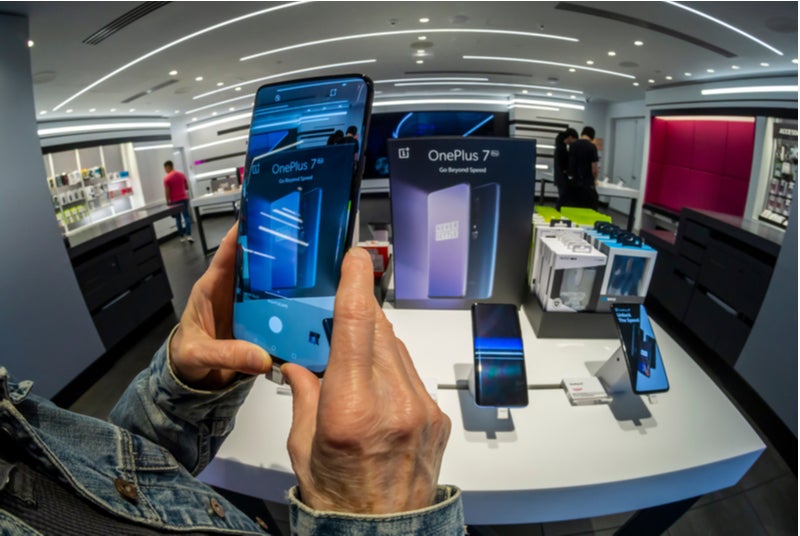
The Chinese smartphone manufacturer OnePlus Technology is making inroads into the US market over other Chinese rivals who are struggling to gain entry.
OnePlus benefits from a small product line that allows it to streamline its resources to offer better support. Also, the overall feature-price value of its phones is helping carriers increase new phone sales and shorten phone upgrade cycles.
Who is OnePlus?
OnePlus is a six-year-old smartphone manufacturer that started with a goal to be a “flagship killer.” It is a subsidiary of China’s Oppo Electronics, with less than 3,000 employees worldwide. OnePlus is also one of the only new Chinese vendors to be picked up by two major US carriers: T-Mobile and Sprint. OnePlus phones offer flagship features at half the cost of the competition and its phones have a smooth, almost stock Android interface, which makes updates easy, and the phones are backed by a strong customer support network.
Limits to Chinese smartphone availability in the US
Carriers remain the primary source of phone distribution in the US and phone manufacturers need carrier support to succeed in this market. Chinese-branded phones have traditionally been sold through the unlocked channel in the US.
How well do you really know your competitors?
Access the most comprehensive Company Profiles on the market, powered by GlobalData. Save hours of research. Gain competitive edge.

Thank you!
Your download email will arrive shortly
Not ready to buy yet? Download a free sample
We are confident about the unique quality of our Company Profiles. However, we want you to make the most beneficial decision for your business, so we offer a free sample that you can download by submitting the below form
By GlobalDataHuawei, one of the top three smartphone vendors in the world, has been under intense scrutiny by the US government and has lost lucrative carrier deals with Verizon and AT&T. At the same time, OnePlus has made advances into this market which other Chinese rivals have been unable to crack.
Why is OnePlus making inroads into the US market?
Smartphone prices have jumped through the roof – some Apple and Samsung flagship products start at $1,000 – which has resulted in consumers hanging on to their phones longer, up to an average of four years and more.
As a result, the US wireless market is seeing the emergence of a new category of smartphones called the junior flagships, which are mid-range phones priced between $300 to $600, which offer some key features that are as advanced as flagships but at half the cost.
The OnePlus 6T at T-Mobile jumpstarted this junior flagship category. The display size of the OnePlus 6T matches Samsung’s $1000+ Galaxy S10+; the 6T was one of the first phones to offer an in-screen fingerprint sensor under $750; its battery capacity rivals that of the Samsung’s Galaxy S10 and the camera resolution is higher than flagships such as iPhone XS and Galaxy S10.
The 6T also comes with 8GB RAM. Most phones in the mid-range offer half that storage capacity. The OnePlus 6T costs $549 – half the price of Samsung and Apple flagships.
The OnePlus 6T was picked up by T-Mobile in November 2018. The device has done so well that T-Mobile offered another OnePlus phone within six months, the high-end OnePlus 7 Pro, which at $699, is almost at the lower end of the high tier. Sprint also started selling the OnePlus 7 Pro 5G in August 2019.
The company’s initial strategy, to offer only one phone a year, has since upgraded to two: one basic phone and one pro version. A small product line compared with rival conglomerates, allows OnePlus to streamline its resources, which translates into better and faster software support, and carriers are using these phones to increase new phone shipments and to shorten the duration between phone upgrades.
What’s next?
OnePlus, with its flagship features at affordable prices, is well placed to take advantage of this trend and more carrier partnerships are expected. Verizon is rumoured to sell OnePlus phones starting late 2019 or early 2020, which will enhance the reach and significantly widen the purchase base for OnePlus. Better junior flagships from Huawei’s Honor and Xiaomi’s Mi brand are available in Europe and Asia, but their absence in the U.S. market gives OnePlus a fighting chance to develop and own this category before rivals like Samsung, LG and Lenovo make inroads. OnePlus has also gradually expanded its product range to offer OnePlus Bullets wireless headphones and will also enter the smartTV market with OnePlus TV. The TV will run Google’s Android TV operating system and be considerably cheaper than rival products.






Related Company Profiles
Google LLC
LG Corp
Apple Inc
Xiaomi Inc